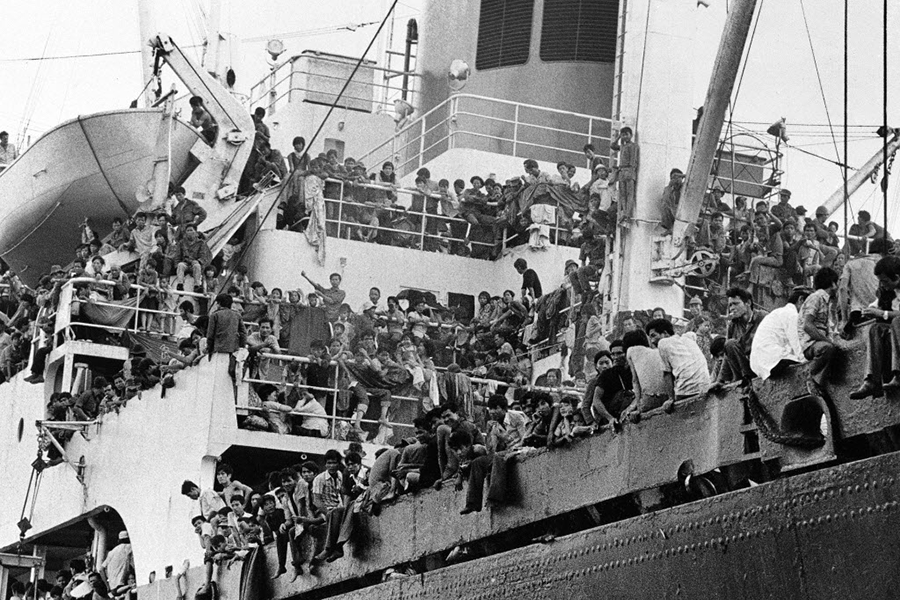Forty years after fall of Saigon, Vietnam now directs anger at China
| Cu Chi, Vietnam
At a complex of underground tunnels and bunkers about 40 miles west of Saigon, an old Viet Cong fighter whose right arm did not survive a tank battle with American troops talks about the guerrillas who inhabited the tunnels.
"Every day we came outside the tunnel to fight," says Huynh Van Chia. "Then we hid." But he acknowledges that the army from the North played the leading role in defeating the Americans. "We are one country," he says.
In fact, one of the commanders of the underground Cu Chi complex was Nguyen Van Linh, a prominent national leader in the late 1980s who reformed the Vietnamese economy along capitalist lines after being a diehard communist leader.
Vietnamese national flags – a gold star on a red field – fly everywhere in the run-up to today’s big parade marking the fall of Saigon, now called Ho Chi Minh City, on April 30, 1975.
In Saigon on parade day, where an inner ring of the city is blocked off, one rarely sees the flag of the Viet Cong, a yellow star on a field that's half red, half blue. The guerrillas that formed the National Liberation Front before the North Vietnamese force took over the war were merged into the army from the North soon after their climactic campaign.
Nor is this country any longer obsessed with the "American war" or the regime in Saigon that Washington worked very hard to support until the end of the war.
If anything, says Admiral Tran Thanh Minh, deputy chief of Vietnam's small navy, the stronger memory today is of Vietnam's border war with China in 1979 and the current threat posed by China's claim to control a large portion of the South China Sea.
Buying US weapons would be ok
"For thousands of years, the Vietnamese people have been fighting invasions from China," he says. "We defeated China with endless spirit."
Considering that China once provided the Vietnamese forces with most of their light weapons, that remark may seem a little ungrateful.
But times are changing. Now, says the admiral, "the sale of US weapons would be a good way to modernize our weapons and increase our strength." He cites a "comprehensive partnership" formed between President Barack Obama and Vietnam's President Truong Tan Sang two years ago.
Yet on the 40th anniversary of the fall of Saigon, wherever you go, memories of a brutal past mingle with images of new beginning.
Revisiting the country that I covered as a wartime journalist for American newspapers and magazines, I'm as shocked by the shining signs of foreign and Vietnamese companies as I am by reminders of war.
In the dense mangrove swamps interlaced with canals from which Viet Cong guerrillas once fired 122 rockets into the heart of Saigon in a day, 50,000-ton freighters now load and unload cargo containers. Overhead, gantry cranes slide up and down on a dock that is 80 percent owned by Dubai Port World and managed by Vietnamese to whom the final defeat of the old Saigon regime is vaguely remembered from childhood but not much discussed.
"There was bombing all around," says Trinh Quang Tuan, manager of business development, looking across a branch of the Saigon River lined with thick jungle that was largely impenetrable to American troops before they withdrew after the signing of the Paris Peace Accords in January 1973. Upstream, he points to a cluster of oil tanks that the Viet Cong occasionally managed to blow up, sending shockwaves of noise and fear across the capital.
Relative prosperity but no guaranteed freedom
"I was in Saigon with my family when the war ended," says Le Chon Tam, director of the Dubai Port World facility. "My parents decided to stay." His father, he says, "worked for the military," but he's reluctant to say which military, the US, or South or North Vietnam.
Such reluctance typifies the responses you get as people carefully balance the overwhelming relief, decades later, of living in a time of relative prosperity while still dealing with an underlying reality. Freedom of speech, freedom to choose, freedom to elect opposition leaders remains out of the question.
You sense the contrasts in stark relief on a visit to the sternly modern central building of Vietnam National University. The institution opened with half a dozen different colleges ten years ago with the mission of providing an inexpensive education.
One student studying journalism was asked how much freedom she is likely to have in the country's controlled media. "That's a question that we are worrying about every day,” she says. "I'm not sure I can answer."
Another student, Nguyen Thi Ngoc Diem, bold enough to give her name, says "We cannot really talk about sensitive problems." But she explains the rationale for control in language the country's leaders might appreciate. "We are fighting for our national sovereignty," she says. "Life is better."
As for the war that happened decades ago, she says, "I don't really know about the past."





